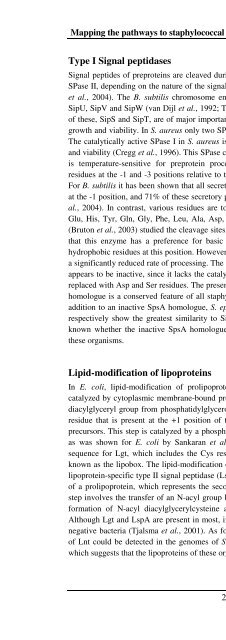The Staphylococcus aureus secretome - TI Pharma
The Staphylococcus aureus secretome - TI Pharma
The Staphylococcus aureus secretome - TI Pharma
You also want an ePaper? Increase the reach of your titles
YUMPU automatically turns print PDFs into web optimized ePapers that Google loves.
Mapping the pathways to staphylococcal pathogenesis by comparative secretomics<br />
Type I Signal peptidases<br />
Signal peptides of preproteins are cleaved during or shortly after translocation by SPase I or<br />
SPase II, depending on the nature of the signal peptide (Tjalsma et al., 2001; van Roosmalen<br />
et al., 2004). <strong>The</strong> B. subtilis chromosome encodes five type I SPases, named SipS, SipT,<br />
SipU, SipV and SipW (van Dijl et al., 1992; Tjalsma et al., 1997; Tjalsma et al., 1998). Two<br />
of these, SipS and SipT, are of major importance for the processing of secretory preproteins,<br />
growth and viability. In S. <strong>aureus</strong> only two SPase I homologues are present, SpsA and SpsB.<br />
<strong>The</strong> catalytically active SPase I in S. <strong>aureus</strong> is SpsB, which is probably essential for growth<br />
and viability (Cregg et al., 1996). This SPase can be used to complement an E. coli strain that<br />
is temperature-sensitive for preprotein processing. In general, type I SPases recognize<br />
residues at the -1 and -3 positions relative to the cleavage site (van Roosmalen et al., 2004).<br />
For B. subtilis it has been shown that all secretory proteins identified by proteomics have Ala<br />
at the -1 position, and 71% of these secretory proteins have Ala at the -3 position (Tjalsma et<br />
al., 2004). In contrast, various residues are tolerated at the -2 position, including Ser, Lys,<br />
Glu, His, Tyr, Gln, Gly, Phe, Leu, Ala, Asp, Asn, Trp and Pro. Interestingly, Bruton et al.<br />
(Bruton et al., 2003) studied the cleavage sites in substrates of SpsB of S. <strong>aureus</strong> and showed<br />
that this enzyme has a preference for basic residues at the -2 position and tolerance for<br />
hydrophobic residues at this position. However, an acidic residue at the -2 position resulted in<br />
a significantly reduced rate of processing. <strong>The</strong> second SPase I homologue of S. <strong>aureus</strong> (SpsA)<br />
appears to be inactive, since it lacks the catalytic Ser and Lys residues that are, respectively,<br />
replaced with Asp and Ser residues. <strong>The</strong> presence of an apparently catalytically inactive SpsA<br />
homologue is a conserved feature of all staphylococci with sequenced genomes. Notably, in<br />
addition to an inactive SpsA homologue, S. epidermidis contains two SpsB homologues that<br />
respectively show the greatest similarity to SipS and SipU of B. subtilis. To date, it is not<br />
known whether the inactive SpsA homologues contribute somehow to protein secretion in<br />
these organisms.<br />
Lipid-modification of lipoproteins<br />
In E. coli, lipid-modification of prolipoproteins involves three sequential steps that are<br />
catalyzed by cytoplasmic membrane-bound proteins. <strong>The</strong> first step involves the transfer of a<br />
diacylglyceryl group from phosphatidylglycerol to the sulfhydryl group of the invariant Cys<br />
residue that is present at the +1 position of the signal peptide cleavage site in lipoprotein<br />
precursors. This step is catalyzed by a phosphatidyl glycerol diacylglyceryl transferase (Lgt)<br />
as was shown for E. coli by Sankaran et al. (Sankaran and Wu, 1994). <strong>The</strong> recognition<br />
sequence for Lgt, which includes the Cys residue that becomes diacylglyceryl-modified, is<br />
known as the lipobox. <strong>The</strong> lipid-modification of the lipobox Cys residue is necessary for the<br />
lipoprotein-specific type II signal peptidase (LspA) to recognize and cleave the signal peptide<br />
of a prolipoprotein, which represents the second step in lipoprotein modification. <strong>The</strong> third<br />
step involves the transfer of an N-acyl group by an N-acyl transferase (Lnt), resulting in the<br />
formation of N-acyl diacylglycerylcysteine at the N-terminus of the mature lipoprotein.<br />
Although Lgt and LspA are present in most, if not all bacteria, Lnt is only present in Gramnegative<br />
bacteria (Tjalsma et al., 2001). As for other Gram-positive bacteria, no homologue<br />
of Lnt could be detected in the genomes of S. <strong>aureus</strong> or S. epidermidis (Stoll et al., 2005),<br />
which suggests that the lipoproteins of these organisms are not N-acylated.<br />
29













